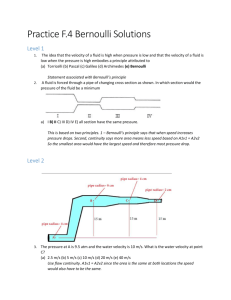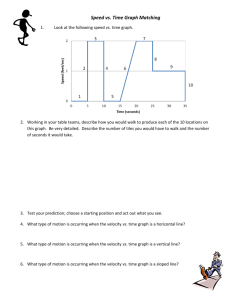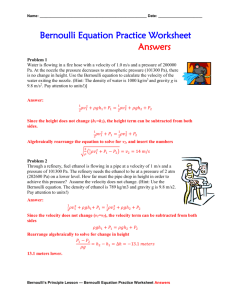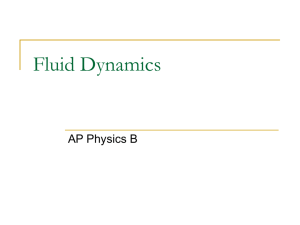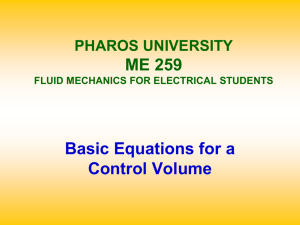Bernoulli's Theorem Verification: Lab Experiment
advertisement
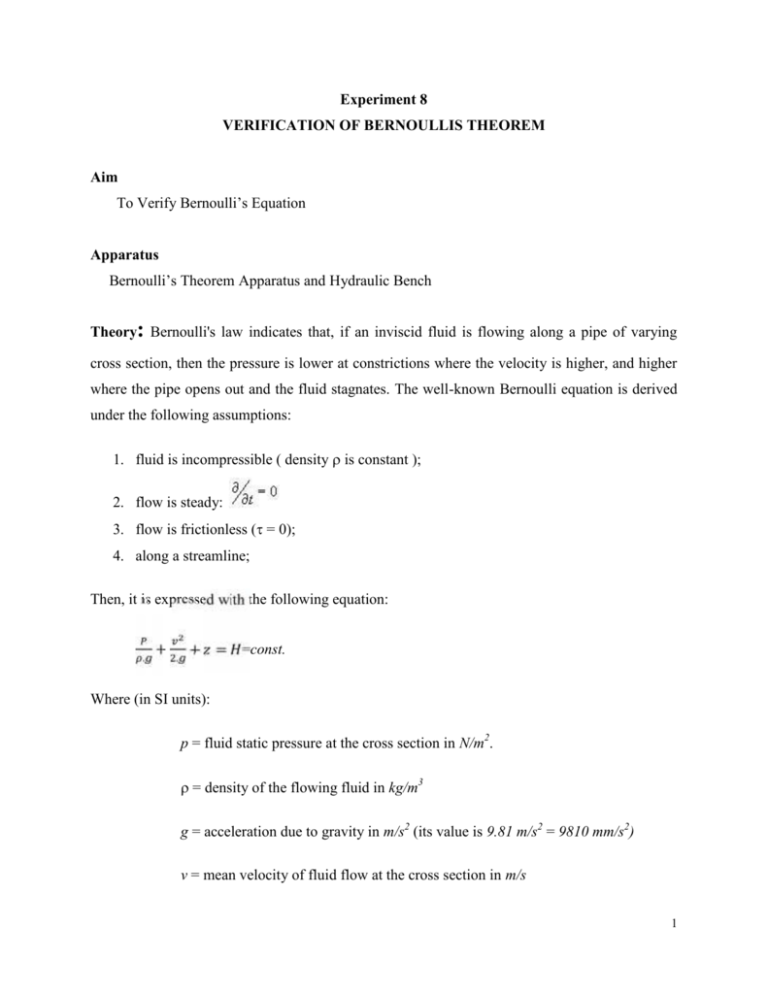
Experiment 8 VERIFICATION OF BERNOULLIS THEOREM Aim To Verify Bernoulli’s Equation Apparatus Bernoulli’s Theorem Apparatus and Hydraulic Bench Theory: Bernoulli's law indicates that, if an inviscid fluid is flowing along a pipe of varying cross section, then the pressure is lower at constrictions where the velocity is higher, and higher where the pipe opens out and the fluid stagnates. The well-known Bernoulli equation is derived under the following assumptions: 1. fluid is incompressible ( density is constant ); 2. flow is steady: 3. flow is frictionless ( = 0); 4. along a streamline; Then, it is expressed with the following equation: . + . + = =const. Where (in SI units): p = fluid static pressure at the cross section in N/m2. = density of the flowing fluid in kg/m3 g = acceleration due to gravity in m/s2 (its value is 9.81 m/s2 = 9810 mm/s2) v = mean velocity of fluid flow at the cross section in m/s 1 z = elevation head of the center of the cross section with respect to a datum z=0 H = total (stagnation) head in m The terms on the left-hand-side of the above equation represent the pressure head (h), velocity head (hv ), and elevation head (z), respectively. The sum of these terms is known as the total head (H). According to the Bernoulli’s theorem of fluid flow through a pipe, the total head (H) at any cross section is constant (based on the assumptions given above). In a real flow due to friction and other imperfections, as well as measurement uncertainties, the results will deviate from the theoretical ones. In our experimental setup, the centerline of all the cross sections we are considering lie on the same horizontal plane (which we may choose as the datum, z=0), and thus, all the ‘z’ values are zeros so that the above equation reduces to: . + . = ´=const. (This is the total head at a cross section). For our experiment, we denote the pressure head as h and the total head as Procedure: ´. 1. Open the inlet valve slowly and allow the water to flow from the supply tank. 2. Now adjust the flow to get a constant head in the supply tank to make flow in and out flow equal. 3. Under this condition the pressure head will become constant in the piezometer tubes. 4. Measure the height of water level “ℎ”(above the arbitrarily selected plane) in different piezometric tubes. Apply enough pressure so that the air trapped goes out from the venture. When using a manometer, remove the air bubbles by using the vent cocks provided/ or by gently taping the manometer tubes. Use the balloon provided for adjusting the water level in the manometer tube. Measure accurately the water level in all the piezometers h and record the values in the observation table. 2 5. Compute the area of cross-section under the piezometer tubes. 6. Note down the quantity of water collected in the measuring tank for a given interval of time. 7. Change the inlet and outlet supply and note the reading. 8. Take at least two reading as described in the above steps. OBSERVATIONS: H = ----- mm Time “t” required to collect 10 litres of water = ___ sec Total head = Velocity head + Pressure head Where, Velocity Head = (cm) Velocity = Discharge = (cm/sec) (cm3/ sec) OBSERVATION TABLE Table 1 Sl No. Section No. Radius (cm) 1 1 1.265 2 2 1.005 3 3 0.87 4 4 0.725 5 5 0.76 6 6 0.845 Area of C/S (cm2) Velocity of flow (cm/sec) Velocity Head cm Pressure Head (cm) Total Head ´= + 3 7 7 0.93 8 8 1.02 9 9 1.105 10 10 1.2 11 11 1.28 Section No. Radius (cm) Table 2 Sl No. Area of C/S (cm2) Velocity of flow (cm/sec) Velocity Head cm Pressure Head (cm) 1 1 1.265 2 2 1.005 3 3 0.87 4 4 0.725 5 5 0.76 6 6 0.845 7 7 0.93 8 8 1.02 9 9 1.105 10 10 1.2 11 11 1.28 Total Head ´= + Results and Discussion 4
